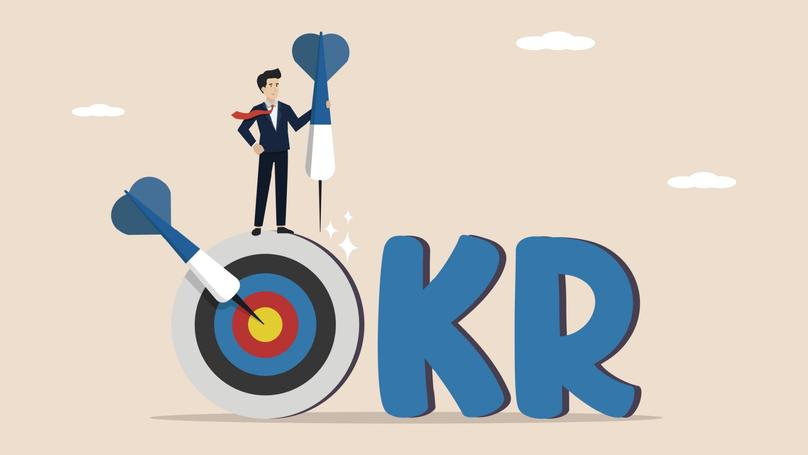OKR (Objectives and Key Results)
What is OKR?
OKR (objectives and key results) is a goal-setting method widely utilized in businesses for project management and team development. Venture investor John Doerr pioneered this definition. He emphasized the importance of aligning your objectives with detailed, measurable outcomes to track progress. This alignment makes goals more transparent, measurable, and grounded-greatly increasing the chances of success. Consequently, this methodology offers significant advantages over alternative approaches.
-
Strategic alignment and clarity
As mentioned above, goals are developed alongside results, fostering a strong connection between the two. This ensures alignment, preventing situations where one aim was intended, but a completely different outcome occurred unexpectedly. This method also enables you to maintain a comprehensive overview, ensuring that all efforts toward achieving the desired result are coherent and directed in a unified manner.
-
A clear focus on priorities and maximum efficiency.
OKR helps prioritize what truly matters by focusing on areas that significantly impact the business. It promotes efficient resource utilisation by clarifying what is required, where it is essential, and in what quantities from the outset. From a team perspective, this approach eliminates redundant tasks and helps concentrate efforts on the most critical current goals.
-
Adaptability and the ability to adjust
OKR is not a fixed method where tasks are established and ignored. Instead, it is a dynamic framework focusing on constant improvement and learning. It encourages regular reviews of progress and essential adjustments to goals. This strategy promotes adaptability throughout the process, ensuring alignment with objectives and minimizing the risk of mistakes.
-
Employee engagement
It is widely recognised that individuals perform more effectively when they have a clear goal and understand its purpose. By enabling a detailed description of tasks and outcomes and maintaining continuous progress tracking, OKR ensures that employees can see their contributions and feel accountable for achieving the overall objective. This transparency eliminates uncertainty about the reasoning behind management decisions, transforming the business into a well-coordinated and efficient system.
OKR Goal Setting

In the OKR framework, goals and results should be clearly defined, and actions must be outlined to achieve them. The OKR framework recommends following several principles to maximize effectiveness when developing all three parts.
When defining your objectives or goals (ideally no more than three), always maintain focus on the desired outcome while considering the following points:
-
Use motivating language that focuses on the ultimate result while highlighting the unique advantages and value of the journey and the steps taken along the way.
-
Ensure that OKR goals push you and your team outside their comfort zones. These goals should be ambitious-pushing beyond previous objectives-while remaining attainable.
-
Make your objectives simple and easy to understand. Avoid using technical jargon or complex terms so that anyone without professional knowledge can easily grasp your message. For example, replace "high ROI" with simpler expressions such as "cover expenses."
-
Avoid using metrics; reserve them for results. The goal defines the theme and sets the strategic direction.
-
Ensure the objective aligns with the company's ongoing tasks while avoiding contradictions. For example, although a goal may focus on increasing KPIs and enhancing ROI, neither should be sacrificed for the sake of the other. Such compromises might be acceptable for individual goals, which will be discussed separately.
-
Establish a timeline for the goal, including a deadline for completing it. It's also crucial to approach these deadlines realistically; within the OKR framework, a goal is usually established for at least one quarter and ideally covers a full year.
After defining your goals, the next step is to establish key results. In practice, key results are tasks or sub-goals. It's crucial to remember that these results act as indicators for monitoring progress and evaluating whether you are moving in the right direction toward your goal. Keeping this in mind, your key results should be:
-
Ultimate. They should convey the outcome, not just an intermediate milestone. They represent the ultimate achievement, indicating that your goal has been wholly actualised and the work is complete.
-
Measurable. Unlike goals, it is acceptable and essential to include definite numerical or statistical indicators here. These metrics should answer the question, "How much?" They can be percentages, quantities, shares, hours, etc.
-
Balanced. Strike a balance between ambition and realism. Goals are meant to drive improvement, so don't hesitate to set ambitious targets that push you beyond your prior achievements. However, evaluating your abilities and the various factors is equally important. Ensure that the outcomes remain within your control while considering external influences that may impact the results beyond your efforts.
Important: Each goal should ideally have up to five key results. Too few may not provide a complete picture; too many may reduce focus.
Objectives and Key Results Examples

Here are some examples of well-defined goals using the OKR methodology:
-
Enhance customer satisfaction.
-
Boost the company's recurring revenue.
-
Increase the number of leads.
-
Decrease the number of rejections during negotiations.
With goal setting, companies must measure their needs with the competitive landscape, client expectations, the available workforce, and regulatory requirements. Objectives such as "Increasing regular income" can be relevant for many businesses. Still, customizing these goals is crucial to attaining specific outcomes that reflect your operations' unique aspects and nuances.
Key results might be expressed as follows:
-
Increase the client base from 100 to 400 people per week.
-
Raise the average spend to $700.
-
Establish a minimum of 5 mutually beneficial partnerships each month.
-
Boost link clicks in email newsletters by 350%.
Distinguishing between results and the actions required to achieve them is crucial. For instance, tasks such as "Install new software" or "Conduct corporate training to improve employee skills" represent actions, not key results. These tasks serve as steps to bridge the gap between the goal and its outcome. Additionally, it is important to recognise the significance of consistency: while all the provided examples of results align with the goal of "Increasing recurring income," only "Increasing the number of clicks on links" directly correlates with the goal of "Increasing the number of leads." This is why it is advisable to limit yourself to five key results per goal-there will inevitably be more actions involved, and having too many can reduce the focus.
Key results can be developed sequentially, executed one after another, or concurrently, in any order. The choice entirely depends on your preferences and the unique features of your business. However, since key results are often achieved irregularly, avoiding rigid sequencing is generally more effective, allowing for a more adaptable and flexible progression.
OKR vs KPI
KPIs are measurements for evaluating employee efficiency in daily tasks or specific projects. In contrast, OKRs represent a comprehensive methodology, whereas KPIs are independent tools that do not depend on goals or tasks. KPIs primarily act as a system for evaluating team performance across multiple areas. Conversely, OKRs adopt a broader, more integrated approach, incorporating various elements. They emphasize a motivational and goal-oriented perspective to enhance productivity and foster progress rather than merely overseeing and managing results.
KPIs are often paired with OKRs to bridge the gap between goals and results as a supplementary tool for tracking progress. As a strictly quantitative evaluation method, KPIs are tied to metrics such as the number of client calls per day or monthly sales figures. A consistent or recurring decline in KPIs can indicate the need to implement OKRs, as this suggests that relying on KPIs alone may no longer be adequate to sustain steady growth.
OKR vs SMART Goals
SMART is an effective goal-setting method suitable for both personal and corporate objectives. The meaning is Specific, Measurable, Achievable, Relevant, and Time-bound, reflecting its criteria.
SMART is often seen as more effective for short-term objectives, while OKRs are better suited for long-term ambitions. OKRs excel when pursuing bold, far-reaching goals that align with your company's overall strategy. Conversely, SMART can be employed to implement process changes and is more practical for daily, straightforward, and achievable tasks. You might think of SMART as a lighter version or a younger sibling to OKRs. While using both in tandem is unnecessary, employing OKR alone may be sufficient, and you can apply SMART principles to smaller or less critical tasks that don't require inclusion in the OKR plan.
OKR for Personal Goals

OKRs, much like other goal-setting frameworks, can be utilized in business and personal contexts. The approach for personal goals remains consistent: establish a particular objective and key results or tasks to support it. However, the planning questions will vary. The goal should be to obtain an answer to "Where do I want to go?" reflecting your unique definition of success in that area. In contrast, the key results should answer, "How will I know I've achieved it?" John Doerr suggests a straightforward formula for personal goals: "I will achieve __________, and I will know this because __________." This method provides an effective way to apply OKRs in your life.
However, if you wish to use OKRs for personal objectives on a larger scale, follow this plan:
Step 1. Identify your priorities
As in business, maintaining focus is essential in your personal life, as achieving everything at once is unrealistic. Identify the areas of your life you want to improve, such as health, social connections, or self-improvement. Establish a clear timeframe-like 60 or 90 days-during which these areas will be your primary focus and hold greater significance.
Ask yourself these questions to identify your priorities:
-
What would I choose right now if I could dedicate all my free time to just one thing?
-
What needs to change from its current state?
-
What is the key outcome I must accomplish today?
Focus on no more than five areas or specific objectives, such as achieving success in a particular activity. You might discover that some areas naturally align with the same outcome. For instance, health can intersect with fitness or beauty, as both contribute to feeling and looking better. Consider merging these into a single goal or temporarily prioritising one over the others.
Step 2. Establish a goal
Earlier, you identified your focus areas but haven't set clear goals-these are not the same! To establish well-defined goals, elaborate on your chosen areas and rephrase them. For instance, consider what success means if exercise is your selected focus. Is it "Completing a 50-kilometer marathon by year's end" or "Achieving six-pack abs?" Both examples are clear, attainable, and reasonably specific, making their intent understandable even to someone without a strong interest in exercise or similar pursuits. This reflects the outcome you're aiming for.
Step 3. Develop key results
The simplest way to determine your key results is by breaking your goal into smaller sub-goals that translate into tasks, ultimately leading to significant results. For instance, running a fifty-kilometre marathon requires preparation. To get started, you may first need to:
-
Complete 10 km in less than an hour.
-
Increase your running distance by X kilometers in a month.
-
Decrease the rest time between runs by X minutes/hours.
-
Perform a minimum of 10 push-ups.
Ensure your key results are distinct from actions and not substitutes. For instance, "Get fitter" is too vague to be a key result, whereas "Run 3 times a week" is an actionable step towards achieving the goal of running 10 km in under an hour, but it is not a key result.
You can also refer to the KPIs we compared with the OKRs and establish conditions for evaluating your progress to enhance your journey toward the goal more focused. For instance, our objective of "Running a 50 km marathon" depends on our running speed, endurance, and frequency of runs. Examine your actions based on these three KPIs to achieve significant results effectively and, ultimately, the goal itself.
Step 4. Align your objectives with corresponding key results
Review the complete OKRs you've developed to ensure the objectives and key results are aligned and cohesively connected. To accomplish this, analyse carefully:
-
If the goal can be reached without meeting the key results, it suggests they were not appropriately defined. Each result must contribute significantly to advancing the goal.
-
How does achieving this key result contribute to your overall goal? Can it exist independently without impacting your primary objective in any way?
-
Could external factors affect your ability to achieve your key result? Ideally, every element should rely entirely on you; if not, some outcomes may be beyond your control. For example, success depends on obtaining approval from your managers, receiving support from a partner, certain weather conditions, etc.
Conclusion
OKR is renowned for being a flexible goal-setting framework, and it is appreciated for its broad applicability and the abundance of supportive tools and practices available. However, achieving success with OKRs extends beyond the framework itself; it involves the journey of reaching those goals. This system doesn't fulfill all requirements automatically; it demands intentional action aligned with your key results. Likewise, refining your approach is crucial for efficiency and ensuring the process remains sustainable and comfortable for you.
This helps sustain motivation and avoid wasting resources-especially with ambitious goals.
Additionally, it helps you keep track of your well-being and that of your team, which is crucial. Adjustments may be necessary along the way, and there's no harm in slightly lowering expectations if you realize you've set the bar too high or chosen a goal that needs improving.
Ensure that you communicate the methodology and its significance clearly to your team. They should understand the value and relevance of the goal just as well as you do. To cultivate collective understanding and commitment, consider introducing OKRs as a shared initiative-preferably as part of a dedicated event.
























